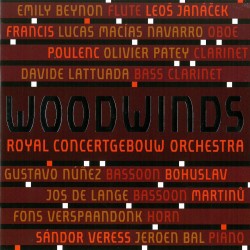 Woodwinds
Woodwinds
Woodwinds of the Royal Concertgebouw Orchestra
RCO Live LC-14237
This varied, attractive program of 20th-century woodwind chamber music presented by Concertgebouw wind players is a credit to all concerned. For me the highlights are Poulenc’s Sextet (1932/39) and Jánaček’s Mládí (1924). The well-known Poulenc is played with sensitivity, and Jeroen Bal’s handling of the piano part is particularly subtle. Fine recordings of this work are numerous: the recent Berlin Counterpoint on Genuin is more energetic and virtuosic; while the London Conchord Ensemble on Champs Hill has a more reverberant acoustic. But to me, the shifting senses of nonchalance, dreaminess and high spirits in the composition are most stylishly captured in this reading.
Jánaček’s late and wonderful Mládí evokes his memories of childhood in Moravia, with instrumental suggestions of speech, song, dance and play. The group projects frequent changes of activity and emotional tone confidently. Intonation is unfailingly accurate and Lucas Navarro’s oboe playing is particularly expressive.
Martinů’s Sextet for Piano and Wind Instruments (1929) avoids consistent style and instrumentation. The Scherzo is to me the best movement; flutist Emily Beynon’s virtuosity and tone make it shine. Gershwin-jazzy passages burst in on several movements, and the Concertgebouw winds turn the whole into a witty, enjoyable experience. The early Sonatina for Oboe, Clarinet and Bassoon (1931) by Sándor Veress (1907-1992) features intriguing dissonance, attractive lyricism and vital rhythm in turn, all conveyed convincingly by the reed trio who seem throroughly at home with the work’s Hungarian folk idioms.



